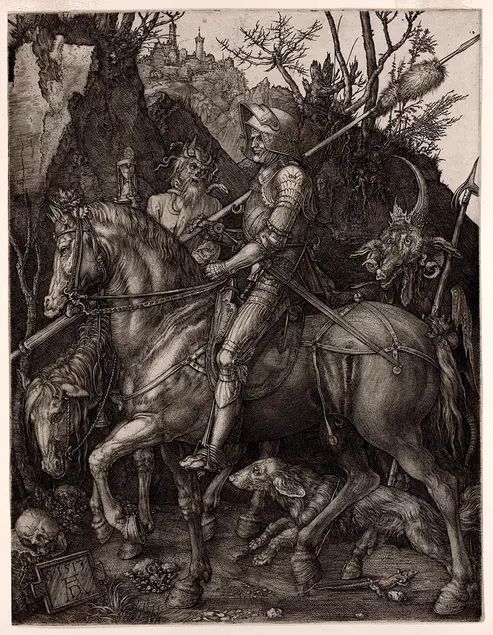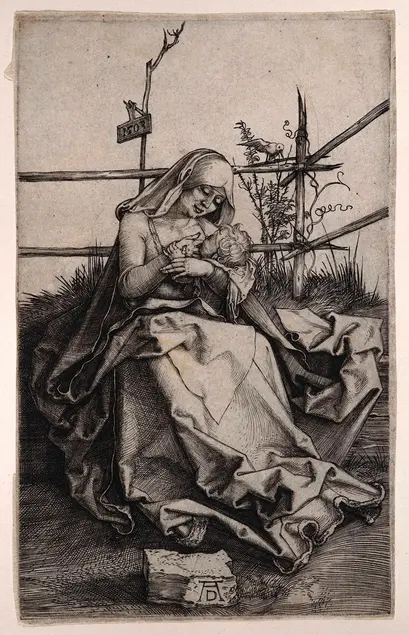Albrecht Dürer: Wanderlust

Albrecht Dürer, Knight, Death, and the Devil, 1513, engraving, 9 1/2 x 7 3/4 in. | The Huntington Library, Art Museum, and Botanical Gardens.

Albrecht Dürer, Virgin on a Grassy Bank, 1503, engraving, 4 1/2 x 2 3/4 in. | The Huntington Library, Art Museum, and Botanical Gardens.

Albrecht Dürer, St. Anthony Before the Town, 1519, engraving, 4 x 5 3/4 in. | The Huntington Library, Art Museum, and Botanical Gardens.
German Renaissance artist Albrecht Dürer (1471–1528) was a versatile artist who was at once a printmaker, painter, theorist, and publisher. Born in Nuremberg, Germany, in 1471, he began to travel to Italy and France in his 20s, and the Low Countries of Belgium and the Netherlands years later. These experiences would significantly shape his artistic education and world view.
This focused exhibition of prints, books, and paintings draws from The Huntington’s collections and features 24 works created during and following his travels to Italy and beyond.
It examines Dürer’s mastery of perspective and integration of Italian artistic principles into German art, establishing him as a pioneering figure in the Northern Renaissance and earning him enduring international renown. The exhibition also presents paintings and prints by contemporaries whom he visited during his travels, including work by Raphael (1483–1520), Giovanni Bellini (1430–1516), and Lucas van Leyden (1494–1533), among others.
Dürer’s skills as a printmaker revolutionized the art of his time. His ability to create a variety of effects using only black lines proved unmatched. His contemporaries and followers copied his woodcuts and engravings or incorporated elements from them into their work. The exhibition shows examples of the dramatic effects created with thick, dense, curvilinear lines, as demonstrated in Samson and the Lion (ca. 1497–98), and delicate, compact cross-hatching, as shown in St. Jerome in His Study (1514). Dürer studied the writings of the ancient Roman architect Vitruvius to understand the “canon of human proportions.” Vitruvius’ theories and his knowledge of classical art inform the design of Dürer’s figures of Adam and Eve (1504), in an elegant contrapposto pose. In the piece, the wooded environment, cliffs, and various animals re-imagine paradise in a northern European landscape. In the engraving Knight, Death, and the Devil (1513), Dürer portrays a rider and his faithful dog unknowingly marching toward the figure of Death, who holds an hourglass to indicate the brevity of life on Earth. Knight, Death, and the Devil; St. Jerome in His Study; and Melencolia I (1514) form the trio of engravings known as Dürer’s Meisterstiche (master engravings).
In addition to showcasing Dürer’s technical mastery, the exhibition highlights his role as an artist-publisher. He started his publishing business in 1498, which allowed him to have greater control over the sale and distribution of his prints. The release of Apocalypse (Apocalipsis cum figuris), a series of 15 large woodcuts depicting the end of the world as described in the biblical Book of Revelation, propelled Dürer to the international stage.
His work was so highly revered that his Life of the Virgin series was copied—down to the “AD” monogram—and disseminated by the Italian printmaker Marcantonio Raimondi. The plagiarism prompted Dürer to initiate the first-known intellectual property lawsuit specific to art. While the Venetian Senate ruled that Dürer’s monogram could no longer be used in copies, the ruling allowed his prints to still be reproduced and distributed by others.
Dürer published some 700 engravings, etchings, and woodcuts. These included individual prints and illustrations designed for books authored by him or others. His final publications included treatises on geometry (1525), fortifications (1527), and human proportion (1528). In his publication Instruction on Measurement, Dürer shares the secret of linear perspective. The exhibition displays two of Dürer’s woodcut illustrations that show how to create images of three-dimensional objects (a portrait of a man and a lute) on two-dimensional surfaces using a perspectival apparatus.
“Albrecht Dürer: Wanderlust” is guest curated by Sophia Quach McCabe, adjunct professor of medieval art and architecture at California State University, Long Beach.
This exhibition is supported by the Douglas and Eunice Erb Goodan Endowment.